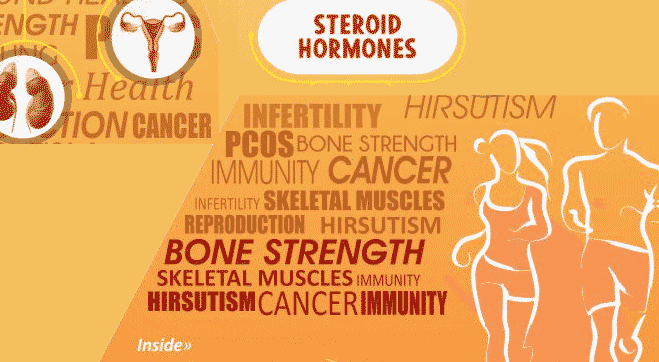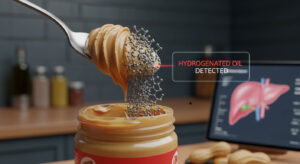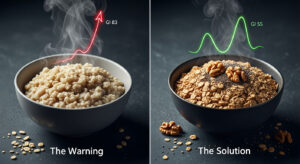Its the little details that are vital. Little things make big things happen
As this famous quote by John Wooden states, the power of small things. Our body too displays
this sight where the complex system is assembled by number of different small components. And
all these things are wired as a circuit with each action connecting to the subsequent one. One
of such small molecules with the power of diverse modulations are ‘Hormones’ forming the roots
of many diverse functions that impacts individual’s behavior as well as functioning. And to our
astonishment a minute difference between all the molecules perform a spectrum of activities.
The crucial most structure of the male and female hormone are an unique example which encompasses a minute difference between the two but leading to the opposite extremes. But as it goes with other things in life, a unique equilibrium is necessary for healthy and happy sustainment, and any deviation in this balance disturbs the whole cascade. Likewise, hormones whose normal regulations goes unnoticed creates a plethora of disturbances that result in conditions making us realize the importance of this body circuit that keeps us going healthy and strong.
Steroid Hormones
steroid hormones are lipophilic in nature as they are synthesized from cholesterol and are used
by body as chemical messengers, where they act on a wide range of tissues and biological functions.
Steroid hormones are synthesized at three main sites-adrenal cortex, gonads and placenta. They are synthesized in the mitochondria and smooth endoplasmic reticulum. Since they are lipophilic in nature, they can easily diffuse from the storage vesicles and hence are not stored there. They are rather synthesized as and when needed as a precursor. These precursors further get converted to active hormones and ultimately, diffuses out of parent cell via simple diffusion as the intracellular concentration increases. The adrenal glands are composed of adrenal medulla and adrenal cortex, Adrenal cortex is divided into three major compartments: the zona glomerulosa, which produces aldosterone; and the zona fasciculata and reticularis, which together produces cortisol and adrenal androgens. Adrenal gland produces progestin, androgen and estrogen in a minor fraction as compared to the total amount of these corticosteroids produced in the body. Adrenal cortex is the primary site for production of glucocorticoids and mineralocorticoids. While the sex hormones estrogen and progesterone are produced from the ovaries, and testosterone is synthesized from the testes.
Classification of Steroid Hormones
Types of Steroids
- Glucocorticoid – Mineralocorticoid
- Sex Steroid – Androgen
– Corticosteroid
– Progesterone
– Estrogen
- Corticosteroids
Corticosteroids are the type of steroid hormones that play a pivotal role in regulation of body homeostasis which enables an organism to resist environmental changes. The effects of corticosteroids include changes in metabolism of carbohydrate, protein and lipid. They affect the modulation of electrolyte and water balance and other vital body systems like cardiovascular, musculoskeletal, nervous, and immune systems. It is important in fetal development, especially in the maturation stage of the fetal lung. Since, many systems are sensitive to corticosteroid levels they show a tight regulatory control. The receptors of glucocorticoid and mineralocorticoid are intracellular and function as hormone-dependent transcription factors.
Glucocorticoids Source
cortisol, also called as stress hormone belongs to this class and is the most clinically important
glucocorticoid which accounts for about 95% of all glucocorticoid activity. They are produced
primarily in the zona fasciculata.
Regulation
Corticotropin secreted by the anterior pituitary gland, in response to corticotropin-releasing
hormone (CRH) from the hypothalamus, regulates the secretion of cortisol. And excessive secretion
of cortisol is prevented by these serum cortisol that inhibits secretion of CRH and corticotropin.
Increased cortisol production results from stress, pain and inflammation.
Mineralocorticoids
Source
Mineralocorticoids are formed in the zona glomerulosa and involves metabolism of salt, water
and minerals.
Regulation Aldosterone is the most potent mineralocorticoid and accounts for about 90% of the total mineralocorticoid activity. Its secretion is regulated, mainly by the renin-angiotensin system while increased serum potassium concentrations also stimulates the production of aldosterone. Increased aldosterone results due to hyperkalemia and angiotensin II while increased sodium concentration to a lesser extent can suppress secretion of aldosterone.
Mechanism of Action in Health They stimulate gluconeogenesis and decrease the glucose use by cells. Major action involves intermediary metabolism, inflammation, immunity, wound healing, myocardial and muscle integrity. It reduces protein stores in all cells of the body, except in liver where it increases protein synthesis. cortisol also increases amino acids in the blood, decreases transport of amino acids into extrahepatic cells, and increases transport of amino acids into hepatic cells. It mobilizes fatty acids from adipose tissue, increases free fatty acids in the plasma, and enhance its use for energy.
High and low levels
Prolonged exposure to glucocorticoids, results in a diabetic-like state due to elevated plasma
glucose, which results due to enhanced gluconeogenesis/glycogenesis.
Low glucocorticoid levels are responsible for hypoglycemia, decreased glycogen stores and also
hypersensitivity to insulin.
In Disease
Cortisol Hypersecretion
High levels of cortisol in plasma is manifested by typical signs including moon-shaped face, buffalo
hump and striae. Cushing was the first to describe the disease caused by a pituitary adenoma that
secretes adrenocorticotropic hormone (ACTH), and is observed more commonly in boys than girls.
Other causes of excess of cortisol are named under the ‘Cushing’s syndrome’. Exogenous use of
corticosteroids is the most common cause of such problems. Growth retardation and weight gain is
observed in a child with Cushing’s syndrome. The high production of other steroids (in case of adrenal
tumours) results in acne, hirsutism, and Hypertension in few cases. Also cortisol have direct effect on
blood pressure.
Mechanism of Action in Health The two main function performed by mineralocorticoid are- to promote tubular reabsorption of sodium and to secrete potassium and hydrogen ions at the collecting tubule, distal tubule and collecting duct. Along with sodium reabsorbion, water gets absorbed simultaneously. This absorption increases the fluid volume and arterial pressure.
High and low levels
Excess of mineralocorticoid results in increased extracellular fluid volume, normal or slightly high plasma
sodium, hypokalemia and alkalosis.
Hypocorticism reflects the opposite effects as that shown in case of excess mineralocorticoid. They include renal loss of sodium, hyponatremia, hyperkalemia, decrease in volume of extracellular fluid and cellular hydration. As small as 1% decrease in sodium reabsorption owing to hypocorticism is sufficient to cause changes in cardiovascular system resulting in circulatory collapse renal failure and even death.
Aldosterone modulates sodium levels by activating mineralocorticoid receptors in the distal tubules of the kidney, leading to increased permeability of the apical membrane of the cells lining the cortical collecting tube.
In Disease
Congenital adrenal hyperplasia (CAH)
CAH affects the levels of steroid hormones that are produced by the adrenal cortex. It is a group of inherited
diseases that result in defective activity of one of five adrenal cortex enzymes (21-Hydroxylase, 11-b-
Hydroxylase, 17-a-Hydroxylase, 3-B-Hydroxysteroid denydrogenase, 20,22 Desmolase). Detective enzyme
leads to decreased production of cortisol, thus increasing the production of corticotropin. Majority of cases
of CAH are caused by 21-hydroxylase deficiency.
In Disease
In Males
An abnormal ratio of T/E i.e. testosterone to estrogen (< 10) has been associated with decreased semen parameters,
and administration of an aromatase inhibitor normalized the ratio and improved sperm concentration, motility,
and morphology. Estrogen levels are targeted and has clinical value for optimizing sperm retrieval rates in men
with non-obstructive azoospermia (NOA).
In Both Males and Females
Cancers
In different forms of cancers such as in breast cancer it is shown by studies that the binding of estrogens to the
estrogen receptors stimulates proliferation of mammary cells. This increases the target cell number in that particular
tissue, thereby, increasing the cell division and DNA synthesis. More the no. of division greater is the risk for replication errors which may result in the acquisition of detrimental mutations that
disrupt normal cellular processes such as apoptosis, cellular proliferation, or DNA repair.
21-hydroxylase deficiency
in this deficiency girls are born with ambiguous genitalia and both boys and girls may have Addisonian crisis and hypotension.
- Estrogen Source These hormones are synthesized by gonads and adrenal glands, and released in the circulation.
Types Estrogen, a hormone with many facets plays a crucial role in both females and males. Three common forms of Estrogens include estrone (E1), estradiol (E2) and estriol (E3).
Mechanism of Action in Health They have a significant impact on different important physiological processes like reproduction, cardiovascular health, bone integrity, cognition and behavior. It is also involved in various diseases like osteoporosis, neurodegenerative diseases, cardiovascular disease, insulin resistance, lupus erythematosus, endometriosis, obesity and different types of cancers.
In Females E2 is the most potent form of estrogen and is present during the premenopausal period in a woman’s life. El is synthesized in adipose tissue and is involved after menopause while E3, the least potent estrogens is generated from E1 and is important during pregnancy upon production from the placenta. Estrogen acts on different target organs which involves uterus, hypothalamus, pituitary, bone, mammary tissue and liver enzymes.
In Males E2 plays a crucial role in modulating libido, erectile function and spermatogenesis. Both estrogen receptors and aromatase enzyme (which converts testosterone to estrogen), are present in large amounts in brain, penis and testis; organs important for sexual function.
In case of ovarian cancer, the steroid hormones as well as the gonadotropins contribute to the etiology of ovarian cancer in humans. The ER is present in approximately two-thirds of human ovarian tumors, with ERB being expressed in tumors of both epithelial and stromal origin, whereas, ERB is abundantly expressed predominantly in granulosa cell-derived tumors and to a lesser extent in mucinous tumors of epithelial origin.
Osteoporosis
Estrogens regulate skeletal homeostasis in both men and women. osteoporosis is due to increased bone
resorption in both females and males which is due to estrogen deficiency. Estrogens inhibit bone turnover
by reducing osteoclastmediated bone resorption and thereby enhances osteoblast-mediated bone formation.
Cardiovascular
Cardiovascular diseases are observed in lower extent in premenopausal women, as compared to those in
menopausal women. This indicates that estrogen protects the female cardiovascular system, and its deficiency
can predispose to risk of stroke.
- Androgen Although known as male sex hormone they are present in both males and females. They develop and maintain masculine characteristics Testosterone in reproductive tissues.
Testosterone
Site
Testosterone is the most important androgen present in the human body. In males it is produced in testes
while in females ovaries contribute 50 percent of circulating testosterone by direct secretion or via precursor
production. The remaining 50 percent is supplied by the adrenal glands.
In Both Males and Females
Pubertal development, sexual function, erythropoiesis, energy, bone density, muscle mass, cognitive function
and mood are impacted by this androgen.
In males, effects of testosterone are most evident during puberty. During this stage they induce deep physiological changes in the male body and lead to development of secondary male characteristics like hair growth pattern, sebaceous gland activity, sperm maturation and libido.
Mechanism of Action in Health Firstly the androgen binds to the androgen receptor (AR) in target tissues to exert its effects. Later, it is reduced to 5 a dihydrotestosterone (5DHT), which also acts on the AR. Testosterone may be converted to estradiol to exert estrogenic effects which typically includes water retention, breast tissue growth and an increase in body fat deposition.
In Disease
In Females
With the decline of ovarian function in menopause, along with the estrogen levels decline, testosterone
availability also declines. Loss of libido is usually observed in post-menopausal or oophorectomized women.
PCOS
PCOS is a hormonal disorder and involves overproduction of androgens that leads to a spectrum of symptoms.
It is associated with increased metabolic as well as cardiovascular morbidity affecting reproductive functions.
PCOS include mainly the ovulation irregularities, increased androgen levels and cystic ovaries.
In Males
Classical Hypogonadism
It is a condition in which testosterone production is below the lower limit of normal. This deficit affects
bodily systems where testosterone action is important and required. Symptoms include weakness fatigue,
depression, irritability, decreased libido, anemia, decreased erectile function, osteopenia/osteoporosis and
decreased facial, axillary, pubic hair.
- Progesterone Source Primary site of synthesis includes corpus luteum and placenta. The availability of circulating cholesterol substrate and low-level of LH stimulates the production by corpus luteum.
Mechanism of Action in Health
This hormone increases diuresis through activation of the renin-angiotensin system, triggers the catabolic
metabolism, relaxes smooth muscle cells, increases excretion of calcium and phosphorus, and raises basal
body temperature. It also display sedative and analgesic effects, improves visual memory, proliferation and
differentiation of osteoblasts and has additionally been found to have an immunosuppressive effect.
In Females
Progesterone famously known as ‘the Pregnancy hormone’, plays an important role in menstrual cycle, prepares
uterus for pregnancy and mammary glands for lactation. Its role is not confined only to females and plays an
important role in males too.
In Males
It instigates spermiogenesis, sperm capacitation/ acrosome reaction and testosterone biosynthesis in the Leydig
cells. It also influences the central nervous system (CNS) via neurosteroids and the effects include blocking of
gonadotropin secretion, sleep improvement, and effects on tumors in the CNS, immune system, cardiovascular
system, kidney function, adipose tissue, behavior and even respiratory system.
In Disease
In Females
Deficiency can lead to preterm delivery, while in obese women, lack of progesterone due to anovulation,
like in PCOS can attribute to endometrial cancer risk.
Luteal Phase Deficiency (LPD)
LPD results from insufficient progesterone exposure that is prerequisite for maintaining a normal secretory
endometrium. Hence deficiency implicates infertility and recurrent spontaneous abortion.
The small steroid hormones astonish us with their unique roles and help us realize the importance of maintaining their precise balance. These small yet magnificent molecules can be detected by various advanced technologies, like LCMS (Liquid chromatography-mass spectrometry), GCMS (Gas chromatography-mass spectrometry) etc.
Testing @ HealthcareOnTime
Thyrocare offers a special Steroid profile which tests 14 different parameters including Corticosterone, Estradiol,
Progesterone, Testosterone, and others using advanced and sophisticated automated technologies at highly affordable rates.








